Lecture 6 (Number 5). Things to do in class
Alfa Heryudono MTH572/472 Numerical PDE
Our goal is to solve a simple ODE on interfal [Tinit,Tfinal]

using Forward Euler, Backward Euler, and Trapezoid. We will also check the accuracy of the method.
Contents
Set up Exact solution and right hand side function
clear all; close all; format long e uexact = @(t) exp(sin(t)); % Exact solution to check. f = @(u,t) cos(t)*u; % RHS function Tinit = 0; % Starting time Tfinal = 1; % Final time / Approximate final time.
Forward Euler
k = 0.1; % Time step. n = ceil(Tfinal/k); % Round up to the nearest integer if needed. tn0 = Tinit; un0 = uexact(tn0); % Initial condition taken from exact solution err = zeros(2,n); % Pre-allocate memory to stores time and error % Now let's march in time. figure('Position',[100,100,1000,400]); subplot(1,2,1) plot(tn0,un0,'ok',tn0,uexact(tn0),'*r'); hold on; % Plot initial condition legend('Numerical Solution','Exact Solution'); xlabel('t'); ylabel('u(t)'); for i=1:n tn1 = tn0 + k; un1 = un0 + k*f(un0,tn0); plot(tn1,un1,'ok',tn1,uexact(tn1),'*r'); drawnow; err(1,i) = tn1; % Store time in the first row of err err(2,i) = abs(un1-uexact(tn1)); % Store error in the first row of err. un0 = un1; tn0 = tn1; end subplot(1,2,2) semilogy(err(1,:),err(2,:),'-o','markerfacecolor','k'); xlabel('t'); ylabel('Error'); xlim([Tinit Tinit+n*k]); ylim([0.1*min(err(2,:)) 10*max(err(2,:))]);
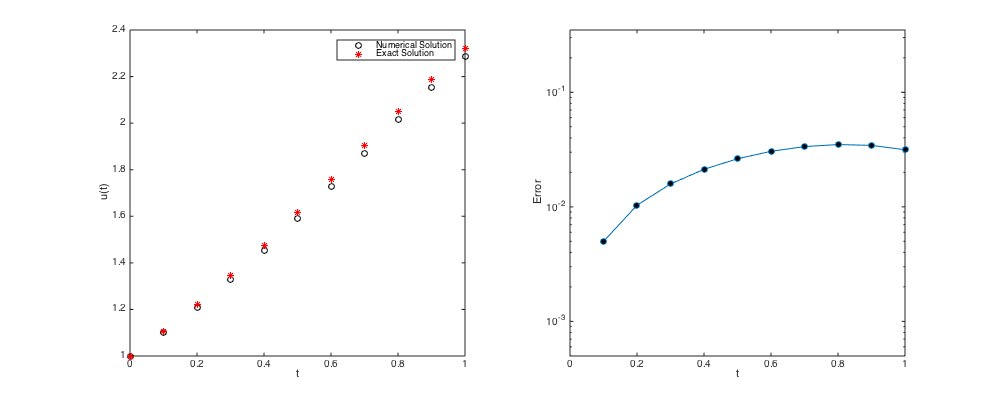
- Error accuracy check of Forward Euler at approximately t = Tfinal.
k = logspace(-4,-1,21); n = ceil(Tfinal./k); err = zeros(1,length(k)); for j=1:length(k) tn0 = Tinit; un0 = uexact(tn0); for i=1:n(j) tn1 = tn0 + k(j); un1 = un0 + k(j)*f(un0,tn0); un0 = un1; tn0 = tn1; end err(j) = abs(un1-uexact(tn1)); end figure loglog(k,err,'-o') xlabel('k'); ylabel('Error at t = Tfinal');
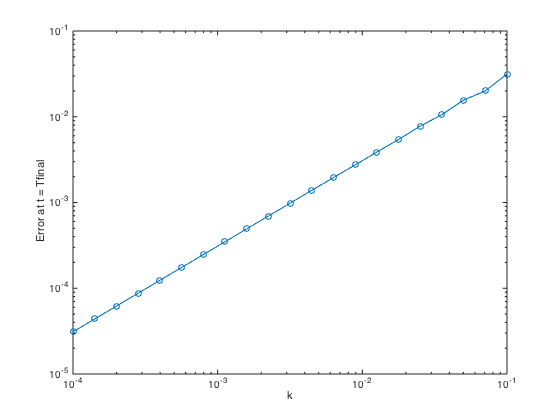
Can you verify the slope of the convergence trend ? is it  ?
?
Backward Euler
k = 0.1; % Time step. n = ceil(Tfinal/k); % Round up to the nearest integer if needed. tn0 = Tinit; un0 = uexact(tn0); % Initial condition taken from exact solution err = zeros(2,n); % Pre-allocate memory to stores time and error % Now let's march in time. figure('Position',[100,100,1000,400]); subplot(1,2,1) plot(tn0,un0,'ok',tn0,uexact(tn0),'*r'); hold on; % Plot initial condition legend('Numerical Solution','Exact Solution'); xlabel('t'); ylabel('u(t)'); for i=1:n tn1 = tn0 + k; un1 = un0/(1-k*cos(tn1)); plot(tn1,un1,'ok',tn1,uexact(tn1),'*r'); drawnow; err(1,i) = tn1; % Store time in the first row of err err(2,i) = abs(un1-uexact(tn1)); % Store error in the first row of err. un0 = un1; tn0 = tn1; end subplot(1,2,2) semilogy(err(1,:),err(2,:),'-o','markerfacecolor','k'); xlabel('t'); ylabel('Error'); xlim([Tinit Tinit+n*k]); ylim([0.1*min(err(2,:)) 10*max(err(2,:))]);
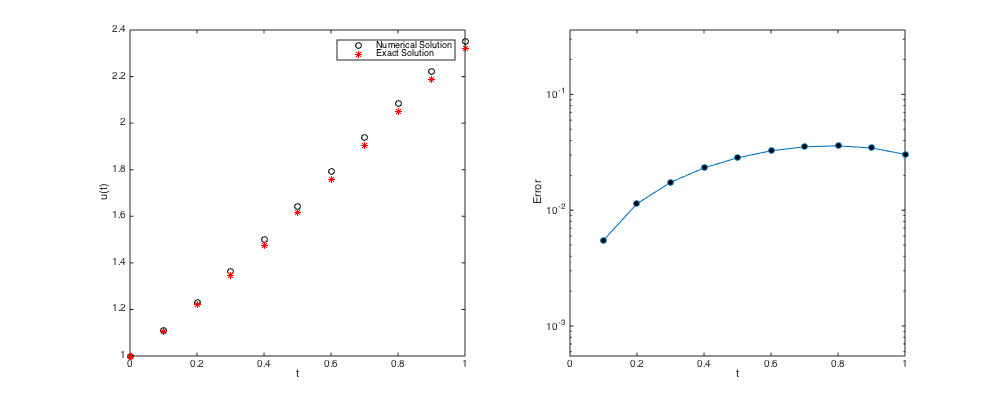
- Error accuracy check of Backward Euler at t = Tfinal
k = logspace(-4,-1,21); n = ceil(Tfinal./k); err = zeros(1,length(k)); for j=1:length(k) tn0 = Tinit; un0 = uexact(tn0); for i=1:n(j) tn1 = tn0 + k(j); un1 = un0/(1-k(j)*cos(tn1)); un0 = un1; tn0 = tn1; end err(j) = abs(un1-uexact(tn1)); end figure loglog(k,err,'-o') xlabel('k'); ylabel('Error at t = Tfinal');
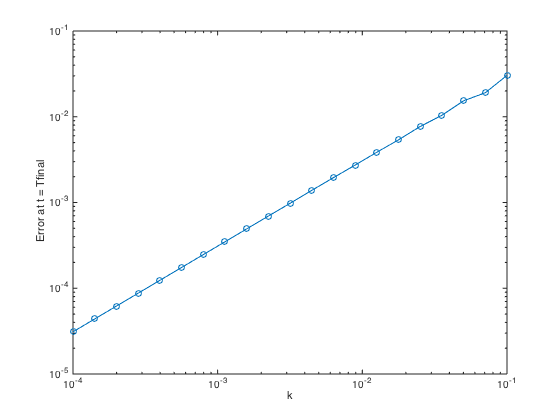
Can you verify the slope of the convergence trend ? is it  ?
?
Trapezoid
k = 0.1; % Time step. n = ceil(Tfinal/k); % Round up to the nearest integer if needed. tn0 = Tinit; un0 = uexact(tn0); % Initial condition taken from exact solution err = zeros(2,n); % Pre-allocate memory to stores time and error % Now let's march in time. figure('Position',[100,100,1000,400]); subplot(1,2,1) plot(tn0,un0,'ok',tn0,uexact(tn0),'*r'); hold on; % Plot initial condition legend('Numerical Solution','Exact Solution'); xlabel('t'); ylabel('u(t)'); for i=1:n tn1 = tn0 + k; un1 = (un0+0.5*k*f(un0,tn0))/(1-0.5*k*cos(tn1)); plot(tn1,un1,'ok',tn1,uexact(tn1),'*r'); drawnow; err(1,i) = tn1; % Store time in the first row of err err(2,i) = abs(un1-uexact(tn1)); % Store error in the first row of err. un0 = un1; tn0 = tn1; end subplot(1,2,2) semilogy(err(1,:),err(2,:),'-o','markerfacecolor','k'); xlabel('t'); ylabel('Error'); xlim([Tinit Tinit+n*k]); ylim([0.1*min(err(2,:)) 10*max(err(2,:))]);
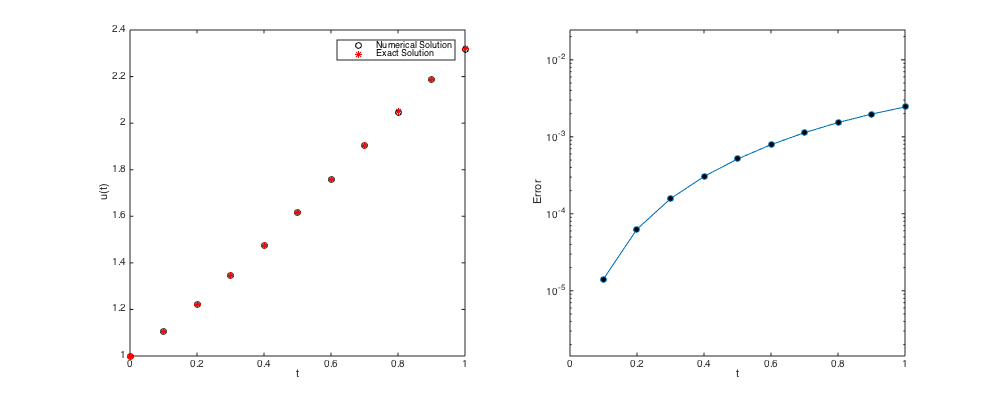
- Error accuracy check of Trapezoid at t = Tfinal
k = logspace(-4,-1,21); n = ceil(Tfinal./k); err = zeros(1,length(k)); for j=1:length(k) tn0 = Tinit; un0 = uexact(tn0); for i=1:n(j) tn1 = tn0 + k(j); %un1 = un0/(1-k(j)*cos(tn1)); un1 = (un0+0.5*k(j)*f(un0,tn0))/(1-0.5*k(j)*cos(tn1)); un0 = un1; tn0 = tn1; end err(j) = abs(un1-uexact(tn1)); end figure loglog(k,err,'-o') xlabel('k'); ylabel('Error at t = Tfinal');
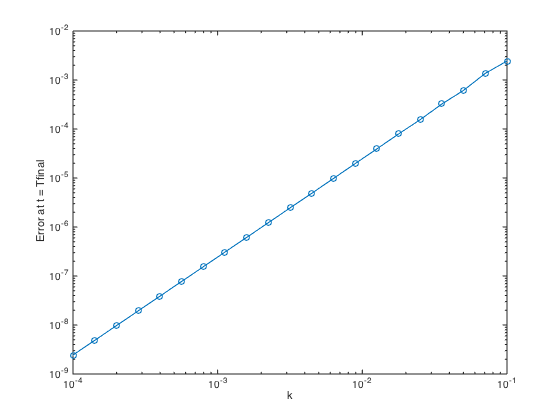
Can you verify the slope of the convergence trend ? is it  ?
?
Redo the problems above with AB3, AM3, and BDF3 in lecture 7.
For this 3-step method, solutions at the first and second steps are not known in the beginning. For simplicity, use exact solutions for the solutions at first and second steps. Verify that they are indeed 3-rd order method.